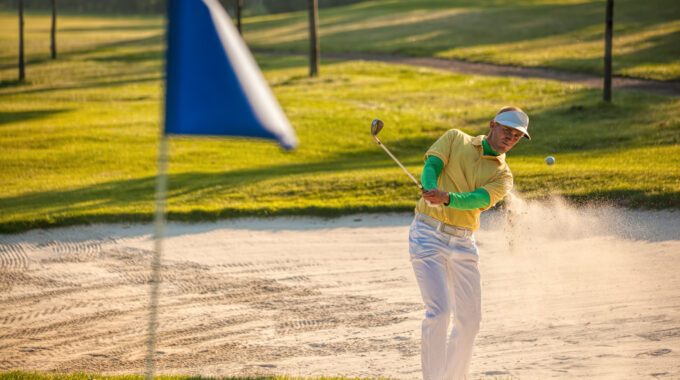Today’s technology has certainly increased the distance golf balls travel. But it has also improved…

Golf 101: How to Get Out of the Mid-Season Slump
No matter how much golf we play in a season, sooner or later we will likely hit a slump. Nothing may necessarily precipitate it, but suddenly, without warning, we may find ourselves in a mid-season slump. Not to worry. As slumps are common problems, there are also plenty of solutions. You just need to determine what works best for you in getting out of a mid-season slump.
Perhaps the first thing to consider is whether your slump is brought about by physical or mental issues — for example, is your swing out of its groove (physical) or are you putting too much pressure on yourself and your game (mental)? There are ways to help both — even though the relationship between the mental and physical aspects of your game can be closely aligned. And a quick look around the internet offers more than a few suggestions to help.
Mind Games
One of the first to catch my eye was this suggestion from Golf Digest’s Jim McLean, who wrote, “If you’re shanking, get help now.” The shanks can be one of those physical maladies that can quickly leak into the mental side. Therefore, we’ll reiterate the “get help now” advice and move on quickly. We never want to spend too much time on the dreaded shanks.
McLean’s suggestion on the mental side of the slump equation is a popular one among instructors and players alike: take a break from the game. Players the likes of Jack Nicklaus and Arnold Palmer told Jimmie Rodgers for his book “Breaking the Slump: How Great Players Survived Their Darkest Moments in Golf–and What You Can Learn from Them,” that taking a break was sound advice. Almost like resetting a stuck computer, the greats have stepped away from the game for a time.
In 1979, Nicklaus put away his clubs for four months after going winless for the first time since 1962 (his rookie year on tour), and when he returned he basically started over. “I started from scratch,” Nicklaus said.
Meanwhile, the King took off five weeks in the middle of the season in 1963 because he was feeling tired and as a result was rushing through everything—from his swing to each round. When he returned to the game, Palmer made a concerted effort to “slow down everything you do,” according to Roberts, and he won three times on tour during the remainder of that season.
Even the venerable Sam Snead was said to go fishing every day when he was in a slump. But such a break might not be warranted for everyone (it’s hard to take off from the season in Minnesota). The slump may need to be overcome by digging in the dirt, as the saying goes.
Swing Thoughts
LPGA star and now PGA Tour commentator Dottie Pepper told Roberts she was slumping so badly one year in college that she feared losing her scholarship. Pepper’s remedy was to rely on one solid go-to shot that she called “a parachute” (for Pepper it was a soft draw) and work through that to build back her swing and confidence.
McLean agrees with that process. It’s good advice to is narrow your focus on the practice range and not go seeking every possible solution.
“My advice is to focus on one type of instruction, and don’t fall prey to every swing tip you see or hear,” McLean said. “Commit to one concept. If the simple “swing the clubhead” message of Ernest Jones resonates with you, don’t mix it with a complicated mechanics-based philosophy. You’ll be surprised at how readily the swing you focused on and dreamed about becomes integrated into your game.”
Physical Solutions
Before you even hit another ball that doesn’t fly how you intend it to, McLean suggests swinging a weighted club to help re-groove a swing and build strength and potentially swing speed in the process.
“A weighted club is the best practice device invented,” he says. “Just remember to swing it slowly and to make sure your motion is as close to the real thing as possible.”
The fix could be as simple as “reviewing your grip and setup,” GolfChannel.com suggests. Bad habits can creep into our games so easily and without our even noticing it—and if your grip and setup have gone awry, everything that follows can as well.
“Alignment errors or poor posture can lead to swing errors and bad golf shots,” according to Golfchannel.com. “Take a look at your grip. The clubface has the most influence on the golf ball and the grip has the most influence on the clubface, so check your grip and make sure it is good. A slumping posture can be the cause of a poor takeaway, limiting your turn and creating a swing that is too upright. An improper tilt with your upper body can lead to a poor backswing and an out-to-in downswing. Set up in front of a mirror, and take a look at your posture and tilt.”
Finally, after taking a break, checking your grip and setup, swinging a weighted club and identifying your go-to shot, you are ready for the practice range—where Golfchannel.com offers one more bit of advice:
“Practice with a purpose. Spend a little more time working on the part or parts of your game where you are struggling. You can work out what is ailing you and the added repetition will help you with your confidence.”
Regaining confidence may be the biggest key of all.



